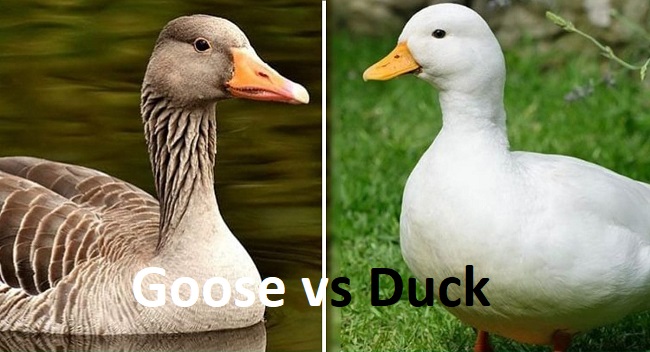Ducks and geese are both well-known waterfowl belonging to the Anatidae family. At first glance, they may seem quite similar, but a closer examination reveals unique characteristics that set them apart.
This article offers an in-depth comparison of ducks and geese, exploring their physical traits, behaviors, habitats, and more.

Physical Characteristics
Here are the physical characteristics:
Read Also:
Ducks
Ducks are generally smaller than geese, with most species measuring 20 to 25 inches in length. They have shorter necks, broad bodies, and strong, oar-like wings.
Ducks also feature a diverse range of colors and patterns in their plumage, depending on the species. Most ducks have a typical “quack,” although some species produce different sounds.
Geese
Geese are larger birds, with most species measuring 30 to 45 inches in length. They have long necks, large bodies, and powerful wings.
Geese have less variety in their coloration, with most species exhibiting white, gray, or black plumage. They are known for their distinctive honking sound.
Behavior and Social Structure
Ducks
Ducks are generally social creatures that live in groups, known as rafts or paddlings. Most duck species are dabblers, meaning they feed on the surface of the water or on land, rarely diving underwater. Ducks are also known for their migratory behavior.
Geese
Geese are very social and tend to form long-term family groups, called gaggles. They are grazers, often seen on land nibbling on grass, seeds, and berries. Geese are also migratory and are famous for their V-shaped flight formations.
Habitat and Breeding
Ducks
Ducks inhabit a wide range of habitats, including freshwater and saltwater bodies. They nest in various locations, often near water but hidden from sight to protect against predators. Female ducks typically lay between 6 and 12 eggs per clutch.
Geese
Geese primarily inhabit freshwater lakes, marshes, and fields. They often nest in elevated, open areas for better visibility. Female geese lay smaller clutches than ducks, usually between 4 to 6 eggs, but invest more parental care into their goslings.
Economic and Cultural Significance
Ducks
Ducks have significant economic value due to their meat, eggs, and down feathers. Certain duck species are also popular in waterfowl hunting.
Culturally, ducks have been represented in various forms of media and are often associated with characters in children’s stories.
Geese
Geese also hold economic importance for their meat, eggs, and down. They are sometimes employed as “watchdogs” on farms due to their alert and protective nature. In folklore and literature, geese often symbolize watchfulness and bravery.
Duck and Goose Diets
Ducks
Ducks have a varied diet that includes aquatic plants, small fish, insects, and grasses. They have a unique feeding mechanism known as “dabbling,” where they upend in the water to stretch their necks below the surface to access food.
Geese
Geese primarily graze on land, favoring grass, roots, stems, and young leaves. They are also known to consume grains, berries, and aquatic plants. Unlike ducks, geese typically feed while on land or in shallow water.
Communication and Vocalization
Ducks
Ducks communicate through a range of vocalizations, body language, and feather displays. While the “quack” is the most famous duck sound, they also use peeps, grunts, groans, chirps, whistles, brays, and more. Each sound communicates specific information such as warnings, feeding calls, or mating signals.
Geese
Geese are known for their loud honking, used for a variety of reasons including warning off predators, communicating with their flock during migration, or signaling distress. They also communicate through hisses, especially when they feel threatened, and soft murmurs when content.
Conservation Status
Ducks
The conservation status of ducks varies by species. Some, like the Mallard, are common and widespread, while others face threats due to habitat loss, hunting, and pollution. The Madagascar Pochard, for instance, is critically endangered.
Geese
The conservation status of geese also varies. While some goose species like the Canada Goose are plentiful, others like the Red-breasted Goose are threatened.
Conservation efforts focus on protecting habitats, enforcing hunting regulations, and monitoring populations.
Health and Lifespan
Ducks
The average lifespan of ducks is about 5 to 10 years, but some have been known to live into their 20s with proper care. Common health issues for ducks include parasites, avian botulism, and duck viral enteritis.
Geese
Geese generally live longer than ducks, with an average lifespan of 10 to 24 years in the wild and up to 40 years in captivity. Geese are relatively robust but can be prone to ailments like angel wing, avian influenza, and parasites.
Read Also:
Conclusion
While ducks and geese share several traits as waterfowl, they display fascinating differences in physical characteristics, behaviors, and habitats.
Understanding these distinctions not only enriches our knowledge of these birds but also heightens our appreciation for the diversity within the animal kingdom.
























